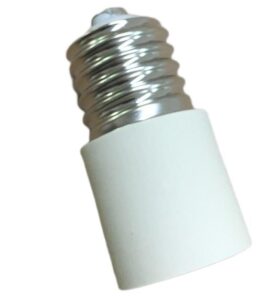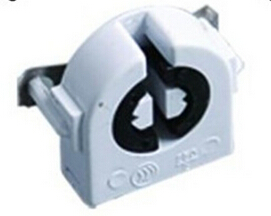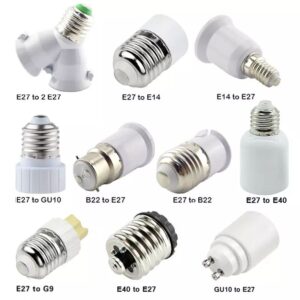Sockets are a really important part of your lighting. They’re what connects the bulb to the electrical system. The material the socket is made from is important to make sure your lighting is safe, lasts a long time, and works the way it should. Different materials are used for different kinds of light sockets, so it’s important to know the good and bad things about each to make a good decision.
Light sockets are made from different materials like ceramic, plastic, or metal, depending on what they’re used for and how much heat and electricity they have to handle.
In this guide, we’ll talk about the different materials used to make light sockets and what makes each one special for certain situations.

Ceramic: High Heat Resistance and Durability
One of the most widely used materials for lamp sockets is ceramic. Known for its excellent heat resistance and durability, ceramic is a top choice in environments where high temperatures are common. This is particularly important when dealing with high-wattage bulbs, such as halogen or incandescent bulbs, which generate significant amounts of heat during operation.
Properties of Ceramic:
- Heat Resistance: Ceramic can withstand high temperatures without melting, warping, or becoming brittle. This makes it ideal for lighting fixtures that use high-output bulbs, as these bulbs produce more heat than lower-wattage alternatives.
- Electrical Insulation: Ceramic is a poor conductor of electricity, making it an excellent material for safely housing electrical components. Its insulating properties reduce the risk of electrical short circuits and shock.
Applications:
Ceramic sockets are often found in:
- Industrial lighting: Where high-intensity lights are used for long periods.
- Kitchen and bathroom fixtures: These environments often require materials that can resist both heat and moisture.
- Outdoor lighting: Ceramic sockets are frequently used in outdoor fixtures where heat and environmental exposure are factors.
Benefits:
- Durability: Ceramic sockets last longer than plastic, as they resist wear and tear from heat exposure.
- Safety: They ensure that the socket won’t overheat, reducing the risk of electrical fires.
If you are using high-wattage bulbs or lighting in areas where heat can build up, ceramic sockets provide the best protection and durability, making them a preferred choice for such applications.

Plastic: Cost-Effective and Lightweight
Plastic sockets are another common option, particularly for lower-wattage lighting fixtures found in homes. While plastic is not as heat-resistant as ceramic, it offers several advantages that make it suitable for a wide range of lighting applications.
Properties of Plastic:
- Lightweight: Plastic is easy to handle and mold into various shapes and sizes, making it versatile for different fixture designs.
- Affordable: Plastic is relatively inexpensive to produce, making it a cost-effective choice for manufacturers and consumers.
- Electrical Insulation: Plastic also acts as a good electrical insulator, though it is not as robust as ceramic under high-heat conditions.
Applications:
Plastic sockets are widely used in:
- Residential lighting: Table lamps, decorative lights, and general household lighting typically use plastic sockets, especially for bulbs with lower wattage like LED or CFL bulbs.
- Decorative fixtures: The flexibility and low cost of plastic make it popular for use in small, decorative lamps or fixtures that don’t require high heat resistance.
Benefits:
- Cost-Effective: Plastic sockets are inexpensive to produce and are ideal for budget-friendly fixtures.
- Sufficient for Low Heat: For most household lighting that doesn’t generate excessive heat, plastic provides enough insulation and durability to perform well over time.
While plastic is not suitable for high-heat applications, it is perfect for low-wattage residential lighting fixtures where affordability and light weight are priorities.

Metal: Conductive and Durable
Metal is another material commonly used in light sockets, but it is primarily found in the electrical contacts rather than the entire socket itself. Metals like brass, aluminum, or stainless steel are used for their conductivity and strength, but they must be paired with insulating materials like ceramic or plastic to ensure safety.
Properties of Metal:
- Conductivity: Metals are excellent conductors of electricity, which is why they are used for the electrical contact points in a socket. They ensure that electricity flows reliably to the light bulb.
- Durability: Metal is highly durable and can withstand physical stress and long-term use, making it an ideal material for socket contacts that need to last.
Applications:
Metal is often used in:
- Heavy-duty fixtures: Industrial lighting, outdoor floodlights, or fixtures that need to withstand harsh environmental conditions often use metal sockets or parts for added durability.
- Electrical contacts: The actual connection points in the socket, where the bulb touches the electrical system, are commonly made from metal to ensure efficient electrical transfer.
Benefits:
- Strength and Durability: Metal sockets and contacts are strong and resistant to physical wear.
- Electrical Efficiency: Metal is a better conductor of electricity than plastic or ceramic, making it the material of choice for the electrical contact points within a socket.
While metal is rarely used for the entire socket (due to its conductive nature), its strength and conductivity make it crucial for the internal components of many light fixtures.

Porcelain: Superior Insulation and Moisture Resistance
A subset of ceramic, porcelain is a refined material that offers even higher levels of heat resistance and insulation. Porcelain is often used in fixtures that are exposed to high moisture or outdoor environments due to its excellent resistance to both heat and moisture.
Properties of Porcelain:
- Heat and Moisture Resistance: Porcelain can withstand extreme temperatures and is unaffected by moisture, making it ideal for environments where these conditions are present.
- Electrical Insulation: Like ceramic, porcelain is a natural insulator, which enhances the safety of the socket by preventing the transfer of electricity.
Applications:
Porcelain sockets are used in:
- Outdoor lighting: Fixtures that are exposed to the elements benefit from porcelain sockets due to their resistance to weathering and corrosion.
- Bathrooms and kitchens: In these environments, where moisture levels are high, porcelain provides the necessary protection to prevent socket degradation.
Benefits:
- Enhanced Durability: Porcelain sockets are incredibly tough and can last for years, even in harsh environments.
- Water Resistance: Their resistance to moisture makes porcelain sockets ideal for outdoor or humid environments, providing long-term safety and performance.
Porcelain is an excellent material for ensuring both heat and moisture resistance, making it a preferred option for outdoor, bathroom, and kitchen fixtures.

Comparing Materials: Strengths and Weaknesses
Each of the materials used in light sockets has its strengths and weaknesses, depending on the application:
- Ceramic vs. Plastic: Ceramic is much more heat-resistant, making it suitable for high-wattage or high-heat environments, while plastic is more lightweight, cost-effective, and suitable for low-wattage household fixtures.
- Metal vs. Ceramic: While metal offers excellent conductivity and durability, it needs to be paired with insulating materials to prevent electrical hazards. Ceramic, on the other hand, is non-conductive and ideal for sockets where heat is a concern.
Choosing the Right Material for Your Lighting Needs
When choosing the right material for your lamp socket, consider the following factors:
- Heat output of the bulb: High-wattage or halogen bulbs require materials like ceramic or porcelain that can withstand the heat without degrading.
- Location of the fixture: For outdoor or moisture-prone environments, porcelain is ideal due to its water resistance. In contrast, plastic is better suited for dry, indoor settings.
- Budget considerations: If you are looking for a cost-effective solution, plastic sockets provide an affordable option for low-heat environments. However, for long-term durability and safety, ceramic and porcelain are worth the investment.
Final Words
Picking the right material for your light socket is important to make sure you have safe, long-lasting, good lighting. Ceramic and porcelain are good for places that are hot or outside because they can handle the heat and the moisture. Plastic is good for your house because it costs less and you don’t need it to handle as much heat. Metal is good to use for the electrical parts to make sure you always have a good connection.
Knowing what’s good about these materials will help you pick the right socket for your lighting, so you can have safe, long-lasting lighting in your house.














